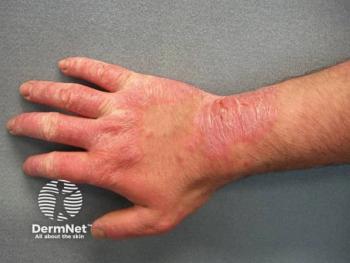
Looking Ahead to Povorcitininb for HS and the Availability of Generic Tofacitinib
Key Takeaways
- Povorcitinib, a selective JAK1 inhibitor, may significantly advance hidradenitis suppurativa treatment, offering new systemic options.
- Generic tofacitinib could replace prednisone for acute conditions, providing similar efficacy with fewer safety concerns.
At RAD 2025, Matthew Zirwas, MD, outlined 2 upcoming shifts in dermatology: the emergence of povorcitinib for hidradenitis suppurativa and the anticipated generic availability of tofacitinib.
“If tofacitinib as a generic is easily accessible as something we can just write and people get it without a prior authorization, it's hard to describe how much that could revolutionize dermatology. It might actually be the end of prednisone,” said Matthew Zirwas, MD, in an interview with Dermatology Times.
Zirwas, a board-certified dermatologist at Bexley Dermatology in Columbus, Ohio, discussed what other areas of dermatology outside of atopic dermatitis he is looking forward to more research in at the
In a
Zirwas noted that HS is one of the largest areas in dermatology that he expects to see major changes in, particularly with oral JAK inhibitors that are wrapping up clinical trials. He is currently involved in the studies of povorcitinib—a selective JAK1 inhibitor—and described the drug as “the most effective thing I’ve ever seen for hidradenitis.” Although his observations are anecdotal, the available clinical data suggest that povorcitinib may represent a promising new approach for patients with HS, particularly given the current lack of systemic options.
Equally compelling to Zirwas is the upcoming generic status of tofacitinib, expected within the next year. Zirwas argued that if access barriers are minimized, specifically eliminating the need for prior authorizations, tofacitinib could displace prednisone as a go-to oral immunomodulator. For acute conditions such as allergic contact dermatitis (eg, poison ivy), tofacitinib could offer similar efficacy with a more favorable safety profile, avoiding prednisone-associated risks such as hyperglycemia, psychosis, bone loss, and immunosuppression.
Importantly, Zirwas believes tofacitinib could offer off-label utility in a broad range of inflammatory dermatoses without FDA-approved systemic therapies. He listed conditions including lichen planus, lichen planopilaris, granuloma annulare, pyoderma gangrenosum, cutaneous lupus, and cutaneous dermatomyositis. For these, a generic oral JAK inhibitor could finally offer accessible, effective systemic treatment.
According to Zirwas, the lingering concern is the cardiovascular risk associated with JAK inhibitors such as tofacitinib.2 However, Zirwas suggested that the MACE and VTE risk profile of tofacitinib may be disease-specific, primarily linked to TNF- and IL-17-driven conditions such as rheumatoid arthritis and psoriasis. As the dermatology community gains a deeper understanding, clinicians may grow more comfortable using tofacitinib in non-TNF/IL-17–driven dermatoses.
Overall, Zirwas anticipates a future where clinicians have both disease-specific innovation in HS and broad immunomodulatory access via generic tofacitinib, potentially redefining treatment algorithms across multiple inflammatory skin diseases.
References
- Chovatiya R, Bunick C, Zirwas M. Medical crossfire: IL-31 and IL-13. Presented at: 2025 Revolutionizing Atopic Dermatitis Conference; June 6-7, 2025; Nashville, TN
- Safety trial finds risk of blood clots in the lungs and death with higher dose of tofacitinib (Xeljanz, Xeljanz XR) in rheumatoid arthritis patients; FDA to investigate. US Food and Drug Administration. February 19, 2019. Accessed June 13, 2025.
https://www.fda.gov/drugs/drug-safety-and-availability/initial-safety-trial-results-find-increased-risk-serious-heart-related-problems-and-cancer-arthritis
Newsletter
Like what you’re reading? Subscribe to Dermatology Times for weekly updates on therapies, innovations, and real-world practice tips.



















